A Paipo
Interview with Steve Zane
March 25, 2011 - Palo Alto, California (USA)
Interview by Kim Green
Steve recalls his teenage years in Hawaii. He started
out, like many
other kids, on a home-made board before buying one of Val Valentine's
Paipo Nui boards. Steve kept riding a paipo while his friends moved
onto stand-up boards. On a recent trip to Hawaii he came across the
Paul Lindbergh's Hawaii Paipo Design
boards, a modern version of the Paipo Nui.
|
1. So what have you got there
(Steve arrived with a pile of magazines and photos)?
I go back to Hawaii every other year. I have
all my relatives there and
I have stuff stored in my cousin's basement that I have to pick up, in
more boxes. This is my friend that passed away in 2002. He did a
certain amount of surf photography when we were kids. I'm on a surf
movie that he made, 8 mm, and also he might have some stills.
Riding paipo or what?
Yeah, I'm on the paipo.
Steve off the bottom. This
and the other water shots
are from 1972-1974. Tom wrote "These were taken with a Nikonos water
camera... he would spend hours swimming around on the inside to get
these shots."

Photos by Robby Witten,
courtesy Tom Witten.
These are all some magazines that I brought along with the ads and
everything.
A lot of ads for paipos.
This is all before the Morey Boogie.
2. Do you think that people were riding more of these
foam style paipos (e.g., El Paipo) than the Val Valentine – Paipo Nui
style wood paipo boards?
Well, in Hawaii, in general, guys used to make
their own, from plywood. I made one as a kid, I forget what it was but
then when like in the mid-sixties or so, I'd go to all the surf shops -
I'm like 14-15 years old, that's where I saw the Val Valentine Paipo
Nui. I remember buying several from the Greg Noll shop in Kaimuki that
was on Waialae Avenue. And also I think I might have bought one from
Surf Line Hawaii which was on Piikoi Street.
Different sizes or shapes or were you just going
through them?
Well, they made two sizes. I remember they had a smaller one and a
larger one. I don't know the dimensions, but probably similar to Paul
Lindbergh boards, the HPDs.
My impression is that they are pretty much the same
profile?
Yes, they are very much like those original Val Valentine boards. I
remember that they
were laminated from three sheets of thin mahogany and glued. He made it
in a press. I believe he died like late-60s or early-70s. He had a
house
at Sunset beach.
Reading all the forums refreshes my memory you know. Because like Paul
Lindbergh, he followed, obviously, that type of design when he did his
wooden boards. I regret not meeting him at the time because he and I
are virtually the same age.
Paul Lindbergh
- Hawaii Paipo Designs: Then and now.
|
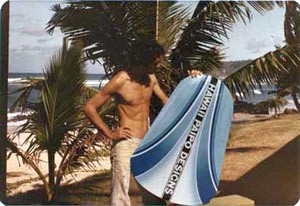
|
|
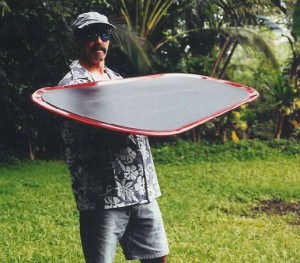
|
Photos courtesy Paul Lindbergh.
But he lives in Hilo.
The Big Island, yeah. But then he was going to Roosevelt High School
(in Honolulu)
where Mr. Murakami taught at.
I remember in the Sixties seeing the original Bruce Brown Endless
Summer
and the MacGillivray and Freeman films at the Roosevelt High
School auditorium and they would actually go there, open up a folding
chair. They'd had their movie running from the projection booth and
they would do their personal narration. I'm a friend of Phil Rarrick --
brother of Randy Rarrick -- he's a big surf promoter and he runs the
surf auction. He shapes under the label Bear Surfboards. I
haven't
attended any of the auctions yet, but if I plan a trip this summer, in
July, I'll check it out. Not as a bidder but just to see the old surfer
personalities and their boards.
In the early days on a couple of occasions, Phil would help out his
brother Randy, and I'd be tagging along and he'd go, "Hey Steve, let's
spend the afternoon together and here's your staple gun and we're gonna
hit all the South Shore spots." On the wooden telephone poles we'd put
flyers to advertise whatever surf film Randy was promoting. That guy
has always been a hustler since day one.
3. Back to the Paipo Nui shape. Your first boards were
boards you made yourself?
Yeah.
What was the shape?
More or less that quote unquote “barn door design.” Those were
relatively crude but it worked. When I was a kid that was what I rode
initially at the “Wall," in Waikiki. That's where I started, but all my
experiences were on the south shore of Oahu, growing up in Aina Haina.
You know when you are a kid you can only go as far as uh... your
friend's mother will take you. They'd drop you off in the morning and
pick you up after work or something. Later on we'd start getting
driver's licenses, we had our Volkswagens, so we could actually chip
in, say three dollars, and go to the North Shore. At thirty cents a
gallon.
So the kids you were riding with had wooden boards too?
Well, when we were like twelve years old, we all maybe started off with
paipos. But as soon as they got bored with that form they started
playing around with surfboards. And I did initially a number of times.
But it never really caught on with me. I didn't really feel comfortable
on it. Though I could balance quite well cause I was a skateboarder. It
was only when I started going to these surf shops that I said, "Wow
man, look at these Paipo Nui boards." It had a concave deck. And the
price was right. In those days it was big time but I could afford
twenty
dollars, twenty-five dollars maybe. But I remember they made them in
two sizes. And I tried both sizes. I forgot which one I actually
settled on. But the dimensions, it's probably like forty inches by
thirty inches on the bottom. Like Paul Lindbergh's boards.
How long would those boards last?
Well, um.. I could get about a year out of them, a year and a half.
Especially like if we were out there on our reef break. Like Aina
Haina, there's different breaks, "Secrets," especially when the sets
are
coming in, if you'd wipe out, and we didn't use leashes, cause this
thing will come back at you. You want to get away from the board on a
bigger wave, but a lot of times the wave would take the board and pearl
it down so that the edge would hit the coral. And then it pops back up
and you notice a big ding. That makes the water intrude. So
subsequently after having the original Paipo Nui start delaminating, I
thought to myself, "I've gotta maybe seal this thing." So I ended up
putting it up on sawhorses, on a new board, and I would get marine
paint, and just paint it. At least three different coats. And that
worked a lot better, preserving the board, and the board still floated.
And
then at one point I started experimenting, looking at Surfer
Magazine,
and all my friends started making surfboards, I started laying up a
skeg with fiberglass. I made a template out of a piece of cardboard,
so I got a hacksaw to saw it out roughly. And then used files to shape
it so it's not like 'erk' 'erk' rough edges. I placed it, maybe ten
inches up from the tail and I glassed in on my Paipo Nui.
Steve at Ledges
|
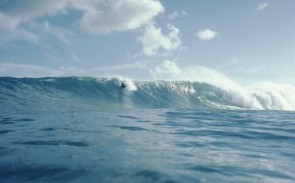
|
|
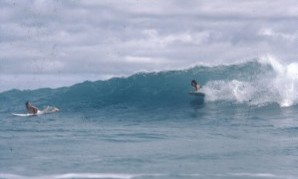
|
Photos by Robby Witten,
courtesy Tom Witten.
And how did that work?
It seemed like it worked pretty good. I don't know if it slowed it down
a lot. When you're riding on a wall it gave a little bit more edge.
Less slipping.
Did that drag the corners?
No, not really. I never experimented with dual skegs. But that single
skeg seemed like it was a good compromise.
So it was fully glassed on the board?
Oh yeah. I remember measuring, positioning it "so many inches" up from
the tail, and getting masking tape
to get the thing straight and canted right. You put like fiberglass
weave on the sides and build up a base. A lot of work. But
unfortunately, after Val died, those boards were no longer readily
available. So I decided
the best thing I could do was use that board as a template. So I went
to the hardware store and bought a piece of plywood. I traced that
out and sawed that out, with an electric skilsaw and tried to round off
the edges and duplicate the board. But unfortunately it was flat,
there's no rocker. And it was good to a certain extent, but it would
pearl all of the time.
Did you do anything to put rocker in?
No, I was aware that there were techniques, but I was a 17-18 year old
kid. I wasn't like Paul, experimenting. I didn't hook up with him then,
or I would have bought one of his. Those wooden boards you see on his
website, they look really good. I'd like to have one of his fiberglass
boards. I saw one for the first time, two years ago, in Waikiki, in a
clothing shop. They carried that old Dave Rochlen style print shorts,
all the retro clothing, and I'm looking around and I see this paipo
board - that's red! And I asked about it and that was the first I heard
about it. It started piquing my interest. I'm interested in the flex
model, HPD design.
I remember that '66, '67, '68 era, I would always pick up these Surfer,
and Surf International magazines, it was out of Australia. But
they had
really good articles. I was fascinated by Greenough, that guy was so
advanced (we are looking at the Surfer Magazine from January
69). And Skateboard magazine, a quarterly. I'd buy these
magazines in our neighborhood Rexall stores. I mail
ordered a Hobie skateboard from one of these companies. I made my own
skateboard before that with a piece of wood and regular metal skates.
We would disassemble the whole thing and only use the truck part, with
a steel axle and washers from the hardware store to make it more
stable, a wider stance.
Like those old thin red skateboards with metal
wheels?
I would ride it down my neighborhood hill in the early morning and the
neighborhood lady would come out and start yelling.
4. The first break you were riding near your house, what
was it called?
I grew up in a subdivision called Aina Haina,
which is on the south
shore of Oahu. It's halfway between Diamond Head and Koko Head, on
Maunalua Bay. Us kids would either ride our little bikes, with our
board underneath the arm, or I would just walk five blocks right up and
cut through a Lutheran church property. And there was about three or
four old picnic benches that we would just sit there checking out the
surf. A lot of time we would check the surf and if it looked good I
would go home an get my paipo board or my friends would go home and get
their surfboards.
Were there other breaks?
There were a bunch of different breaks. It all depends on the swell
angle and the size. Different breaks would emerge as you got a bigger
South swell. Wailupe Circle, then Aina Haina, and when it was big –
Ledges.
We called it Ledges because the coral heads were very large. Especially
on a low tide situation, it was right there. So there was a certain
amount of trepidation. There was another peak we called Robby's,
because we named it after my now departed friend, Robby Witten.
Because he's the guy that would paddle away from the pack and he would
just sit and just wait for that one particular outside wave to come.
Also called Secrets, primarily a right break. I don't know how secret
it is anymore.
Steve at Ledges
|
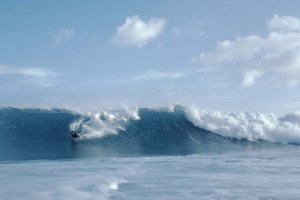
|
|
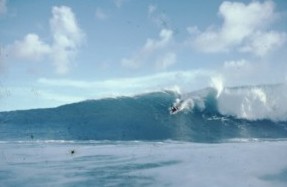
|
Photos by Robby Witten,
courtesy Tom Witten.
Everyplace has got a "Secrets."
And further down by Niu valley was "Toes." That was a good long left.
5. Was that just paipos or were there stand-ups, too?
No. I was the oddball. Once we were in 9th
grade or so most of my
friends, some of whom never paipo'd, started getting into the
longboards. Then we were talking about the 1966 to 1969-1970 era they
all got
into shortboards.
But I just kept in the prone position.
Did they give you any grief because of that?
No, not really. Because I was just one less person to deal with in the
lineup.
Because you're closer inside?
Well you know it's hard to catch a wave when you're on your belly with
Duckfeet fins. I have to position myself, a lot of times, away from the
pack. And pray for an outside one where those guys are not there. On a
really nice swell day there would be twenty of us trying to position
ourselves, at least. More so
on a bigger swell. People would be paddling in from all different
angles. So they never hassled me, they thought well, he's doing his
thing.
Steve taking off.
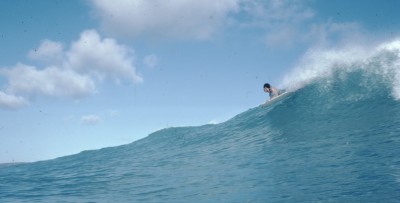
Photos by Robby Witten,
courtesy Tom Witten.
6. Were you still there when body boards started
appearing?
I was still there. That's when Phyllis Dameron,
I knew her before she
was Phyllis Dameron, that's her married name. I think her name before
was Phyllis Albrecht.
Phyllis
bodyboarding in the 1970s
|
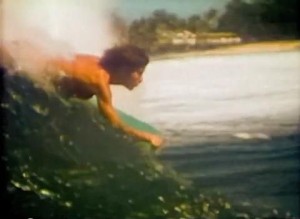
|
|
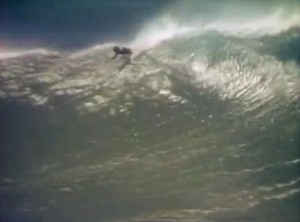
|
Photographer unknown.
Was she a paipo rider at all? I know about her
bodyboarding.
No, I don't think so. She was younger than I was, but I remember her on
certain days out in the lineup. But after the 1974-75 era, I had other
things going on in my life as I just didn't paipo that much and Phyllis
started making a name for herself, charging Waimea and getting in the
limelight.
Did she live in the neighborhood or something like
that?
Yup, I had neighbors all over the place, scattered, people that I have
known a lot of my friends that I'm only fully understanding now what
they are doing. Terry Chung, lives in Kilauea or Hanalei area on on
Kuaui, he's a big time shaper. That new Jack McCoy film, A Deeper
Shade
of Blue, features him. He shapes boards that he exports to Japan
and
Brazil and different outlets. He shapes boards for Laird Hamilton. He's
one of his buddies. One of the three Pang brothers from Niu Valley,
Dennis Pang, he lives in Hali'ewa. I haven't seen him since 2002, at my
friend's funeral, Robbie Witten. He's a professional shaper on the
North
Shore. And one of my friends, Phil Rarrick's brother, Randy, is a
professional shaper and promoter. He's only had one avocation his whole
life, surfing. So he's made surfing his business, in all aspects. I
knew Buddy Dumphy who was originally from Kuliouou. Then his parents
owned a restaurant near the Ala Moana shopping center. Buddy was a
professional shaper for Surfline Hawaii until his demise.
Unfortunately,
in the early-1990s, he got involved in a head-on collision up on the
North Shore, because he commuted between Kawela Bay, where he was
living,
and Surfline. But Buddy came up one time on the line-up, and he would
experiment with different boards and he built a Greenough style
kneeboard.
7. Were there many kneelo style riders when you were
there?
No. People would sometimes try and emulate that
Greenough style
fiberglass spoon board with the edges, but I remember seeing Buddy with
that board, it's hard to catch a wave, you have to wait until the wave
is almost breaking because it's hard to paddle into it. And it wouldn't
float like a Paipo Nui. A Paipo Nui has a certain amount of buoyancy.
But a lot of time it was like those kneeboards would float almost
vertically in the water. Because only the rails and the nose section
would float.
When you talk about the Paipo Nui having more float,
how much float are you talking about?
Well, not as much as a Morey Boogie, but that's the joy of the board is
that you can go under a wave when they're breaking.
The HPD is just above neutral buoyancy, you can just
push it down.
I tried kneeling on occasion on my Paipo Nui, but I was never really
good at it.
Two knees or drop knee?
Well, two knees or... but that's why I put that little skeg on, because
you don't have any stability when you don't have your feet dragging in
the water to direct it. And I rode exclusively on Voit Duck Feet. I
tried my friend's Churchills, I never liked them. They were very good
on the foot, but they didn't have enough thrust because of the surface
area and they were cut asymmetrically. But I haven't tried any of the
new fins. One of my issues though, because I wear prescription glasses,
and because my vision deteriorated, it gets harder and harder to see
the waves. Though now, in my research I see you can get prescription
goggles, surf glasses. Even with polarized lenses.
I got Lasik for surfing and skiing.
If I got that it would be no problem.
8. When the Morey Boogie came in did that affect the
lineup? The number of people riding paipo?
On my particular home break at that time, which
us locals only knew
about because you had to cut through private property or someone's yard
to get there. Not much accessibility, though I guess there is a beach
park now there, that a lot of people park at, further down. It was
called Secrets, because it was our secret spot. But I did go to a lot
of the more known breaks like Makapu'u, especially when there was a
particular sell, we'd go outside Makapu'u. I had some memorable days
there, with overhead six to eight foot surf. And also Sandy Beach. Now
Sandy Beach proper where people bodysurf, you don't paipo there.
Because it's a beach break and it's primarily for bodysurfing. If you
rode a hard paipo, there's a good chance that you'd decapitate yourself
or somebody. But we'd go to Sandy Beach when there was a certain swell,
when it would break outside. That was where all the board surfers would
go. I had a couple of memorable sessions out there. Another break that
I liked to go to is Kewalos, outside Kewalo Basin Harbor. On the right
hand side is Point Panic -- it used to be open to all types of surfing
--
now I think they limit it to just body surfing. But all these breaks
needed a certain swell, direction and size. So Kewalos was one, going
down there's more like Ala Moana, that harbor. But that was pretty much
dominated by longboard surfing, so I would go a little bit further,
there was another break – Rock Pile. All the big guns would be at Ala
Moana, and us little gremmies would be paddling around Rock Pile.
Point Panic.
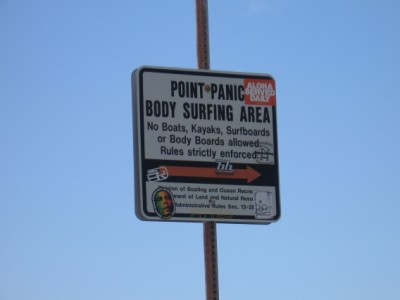
Photo courtesy Steve Zane.
Every once in a while you'd see paipos, I wasn't paying too much
attention to who's doing what when I'm like 15 years old. But the
commonest spots would be Makapu'u, the Wall, or Queen surf. When that
was good, a lot of the guys would come out of the woodwork for those
spots.
Now the contingent of the guys that are like keeping
the paipo flame alive are all older guys. That is good.
A lot of the younger guys don't know anything about paipo because they
were born in the late-Seventies and started out on Boogie Boards. I
tried the Boogie Board, because my friends would try them, we'd be
fooling around. What I didn't like about them was that I couldn't go
under big surf. You'd have to tether them to your wrist on a leash. But
my impression of the Boogie is when it first came out and the density
of that foam was relatively soft. And it flexed too much. I wanted
something that had a little more stiffness. But now the newer boards,
the Turbo Surf, that guy Brown was making, I believe he made with
certain stiffnesses. That was Russ Brown,
I guess he gave up the business in 2008.
I guess you need flexibility with a bodyboard, not
position like a paipo.
Though with the advent of the bodyboard people are doing a lot more
radical manoeuvres, without any repercussion of getting nailed by your
own board. If you get hit in the head it's just a piece of foam. If you
get hit by a 15 pound piece of wood...
But primarily all my breaks were on the South Shore. My experience is
with two to six food surf, big time might have been eight. But my
biggest experience was at Ehukai beach, six to eight, I caught some
pretty good waves but with the rip currents, and being young, it's kind
of scary. North Shore, I had limited experience up there because as a
kid you have only a certain amount of accessibility. But later on when
we all got our driver's licences, we all had Volkswagen bugs. And we'd
be like OK, you give me 50 cents and you give me 50 cents and four guys
with like two three dollars of gas we can go around the island and come
back. And we'd go to these certain spots. Velzyland. I tried Sunset
Beach but the rip currents there were so much I just stayed inside.
Ehukai Beach, couple of times to Chuns Reef.
This is when you were in high school?
Yes and a few years after. The North Shore was when like school was
out, a Saturday or Sunday adventure. But it really helps being close to
the water. If a kid is close to the water, and you have a pretty good
break, that becomes your home break. So you develop a certain amount of
skill.
9. Mark Cunningham?
I met him a few times, he's a famous waterman
on the North Shore, a
county lifeguard. Some of my friends are more friends with him. He
never paipo'd as far as I know, or he may have, I don't know. He's more
known as a bodysurfer.
10. Did you ride other boards after the Paipo Nui?
My homemade paipo board that I made a template
out of. After that I
never did. But now that I know HPD has boards I could get one of those.
And I guess I've got to invest in a full length wet suit while we're at
it.
[The water in Central California is considerably colder water than
Hawaii.]
When did you come over here?
The first time about 1976, or so, then from 1993 on a permanent basis.
Steve and boards at Surf Line Surf Shop, in Hawaii, 2012.
Photos courtesy Steve Zane.
11. Looking at Steve's photos.
This is my friend Tommy Witten and his brother
Robby.
Riding paipo or what?
Yeah I'm on the paipo. These are all some magazines that I brought
along with the ads and
everything.
What the heck has he got strapped to his board?
His brothers ashes. They were going to be scattered at the spot we
surfed at.
You had to paddle out?
Yes, you see all these guys went out to the lineup to scatter the ashes.
Those are nice looking boards. So he was one of the
old time guys?
We all grew up in the neighborhood in the Sixties and Seventies and
we'd all
congregate down here at this church. We'd all sit down here on this
lawn on the picnic benches and scan for surf all the time and check out
the waves.
12. Looking at Steve's photos.
I notice that on Paul Lindbergh's boards that
he glues on a piece of
neoprene to pad your chest. What I did in Hawaii, the points on your
ribcage hurt, to give you more stamina, I would wear like an O'Neill
vest. So instead of having it glued to your board its on your body.
It's more like a yoga mat, a little stiffer. And you
don't have to wax it.
I used to wax my Paipo Nui.
All over or just on the edges?
Kind of the central part, the gripping surface too, where your hand is.
But whenever I surfed I'd always hold the board.
Not superman?
I'd always have one hand on the nose and a lot of time in radical
manoeuvres I'm torquing it, leaning through.
Do you typically hate the one hand forward one hand
back stance?
I think I had typically two hands forward.
What's your take off stance?
One hand is on the nose, both feet are kicking like mad, and I'm right
handed so I'm using my left hand to paddle.
13. So you had enough float on the Paipo Nui to actually
paddle?
Well it depends on how early you want to catch
the wave. To me it's
easier to get on the wave early rather than doing a late, steep drop.
I have to take a late drop around here to get a wave
at all.
Another thing is the spots were becoming more crowded, it become
difficult to get a good wave on a good day when everybody has a long
board and you're the only one in the water with a piece of wood. It
becomes very discouraging when you can't catch anything.
Stand-up paddle boards.
Riding a paipo is more like a go kart or a formula one car verses a
stand-up paddleboard which is like surfing on a sofa.
Sweeping. Bring the family.
Until you see people like my friend Terry Chung or Laird Hamilton in
Hanalei.
There are guys that can do it.
14. Now we are looking at a map
of Honolulu on the leeward
side of the island.
No, this is the south shore side, leeward
is more towards Makaha.
When you were talking about the breaks
earlier and how
far you had to go. These are like blocks between breaks. They're very
close.
Sometimes on days with my friends surfing it,
using my Duckfeets, I
would just paddle a quarter, half a mile. A lot of the general public
never knew about these breaks because you don't have any access, it's
all private property. People would always go off Diamond Head or the
Waikiki area where there are mutiple breaks.
I thought Paul Lindbergh was from Hilo?
No, he went to high school at Roosevelt, he grew
up in Makiki, on Oahu.
He talks about Mr. Murakami and shop class. I don't know if any of your
paipo friends saw this but as a kid I saw Val Valentine narrate his
movies that he was showing and it was McKinley High school auditorium.
This is like in the 1965 era. I remember my mother dropped me off.
So Val Valentine was narrating his own films of
Hawaii.
Yeah, I remember seeing films of paipos dropping
in at Waimea. So that
was probably John Waidelich riding Waimea.
I've heard, too, that Val Valentine really
wasn't the
board maker, he was like the promoter?
No, he made his boards. But he was also known for
making surf films.
Tickets were like 75 cents – a dollar fifty. I remember paying that to
go to see Endless Summer.
Was he promoting paipos?
No, he was just trying to show a surf film. Why he
started making paipo
boards I have no idea. Maybe he just thought like Morey, “Hey, I'm
going
to make this device and it will catch on and I'll make some money."
Well like Noll, I don't think he had any real
interest.
But like I said I bought it in several shops, the
Greg Noll shop in
Kaimuki on Waialae Ave. I think Surfline might have carried them, too,
in
the place on Piikoi St., no longer there. There were a lot of different
shops that came and went. Weber Hawaii, Dewey Weber had a shop. And the
North Shore shops. Country Surfboards.
Makua
& Kila, Waikiki.
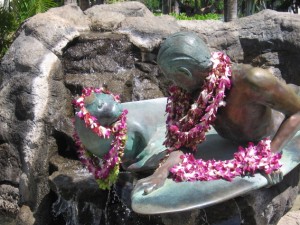
Photo courtesy of Steve
Zane.
|
Postscript, Steve Zane,
February 3, 2012
I found this September 1975 slide of my homemade paipo board. I guess I
attempted to
put "rocker" in it with a wet towel and a large rock. It was weighted
over a wooden box and a wooden step stool. It never crossed my mind
that I ever attempted to do this technique, which obviously didn't
work. Quite crude and humorous. Can't stop laughing...... Aloha,
Steve
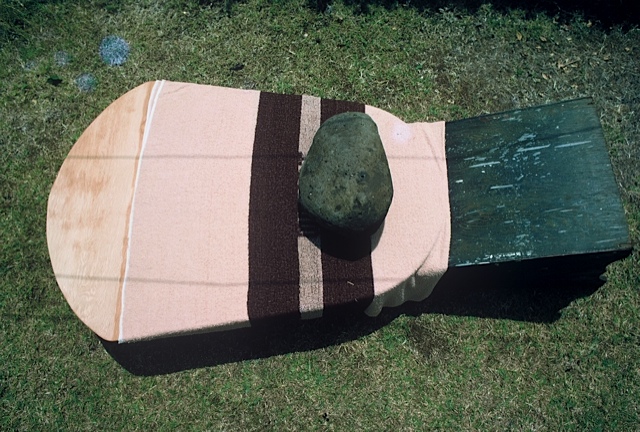
Photo
courtesy of Steve Zane. |
Notes:
Many thanks to Tom Biggs for cleaning up two of Robby Witten's photos
and to John Clark for assistance with the spelling of Hawaiian place
names.
|
|